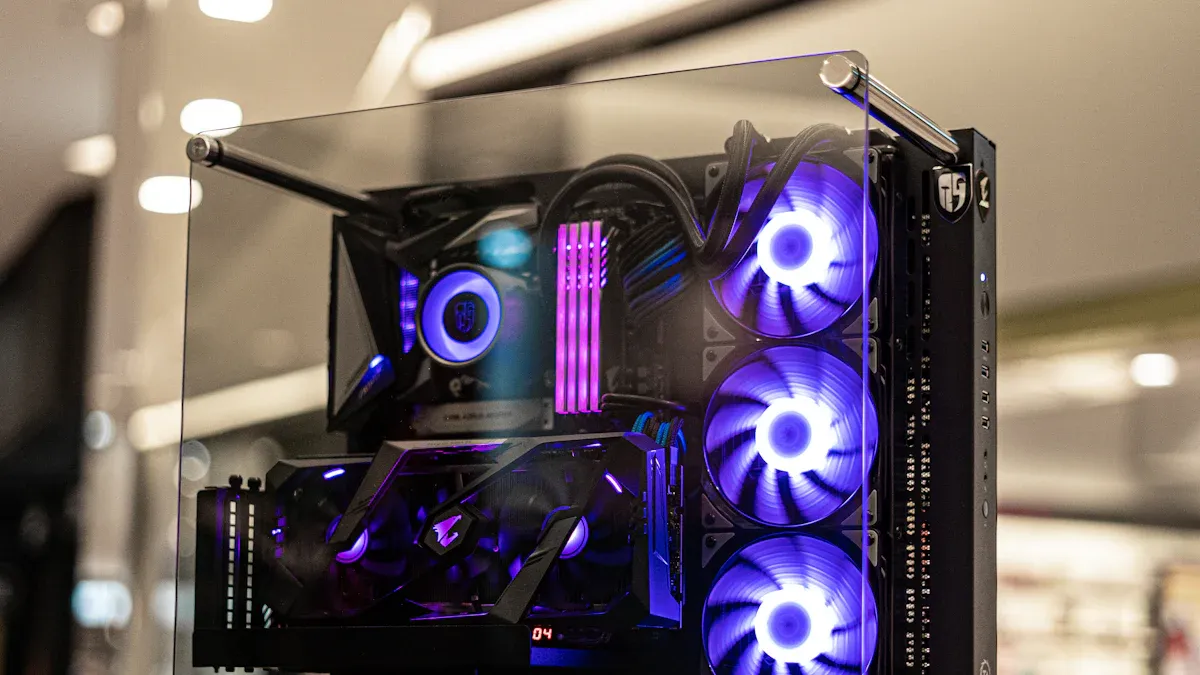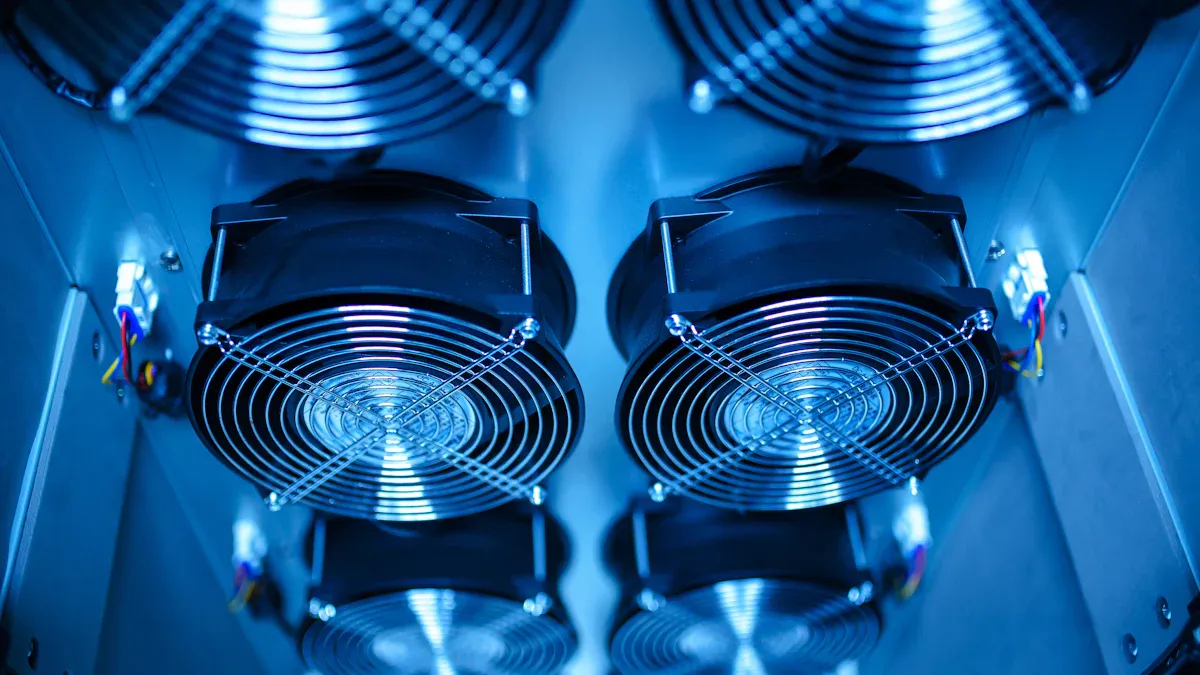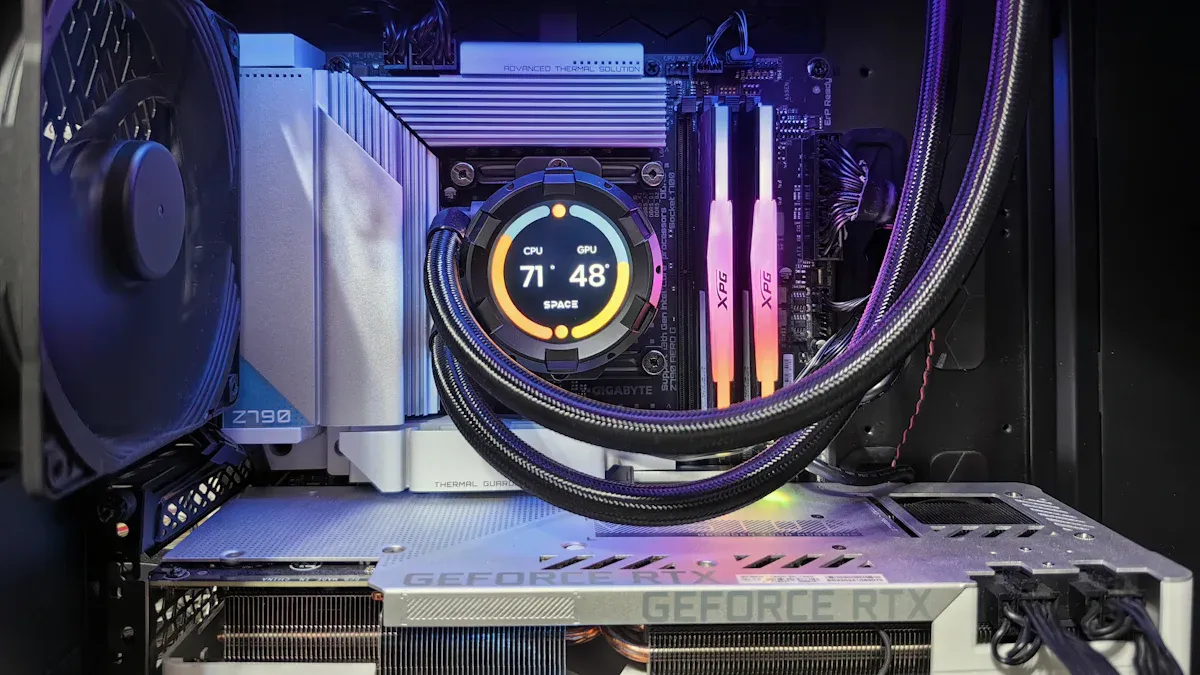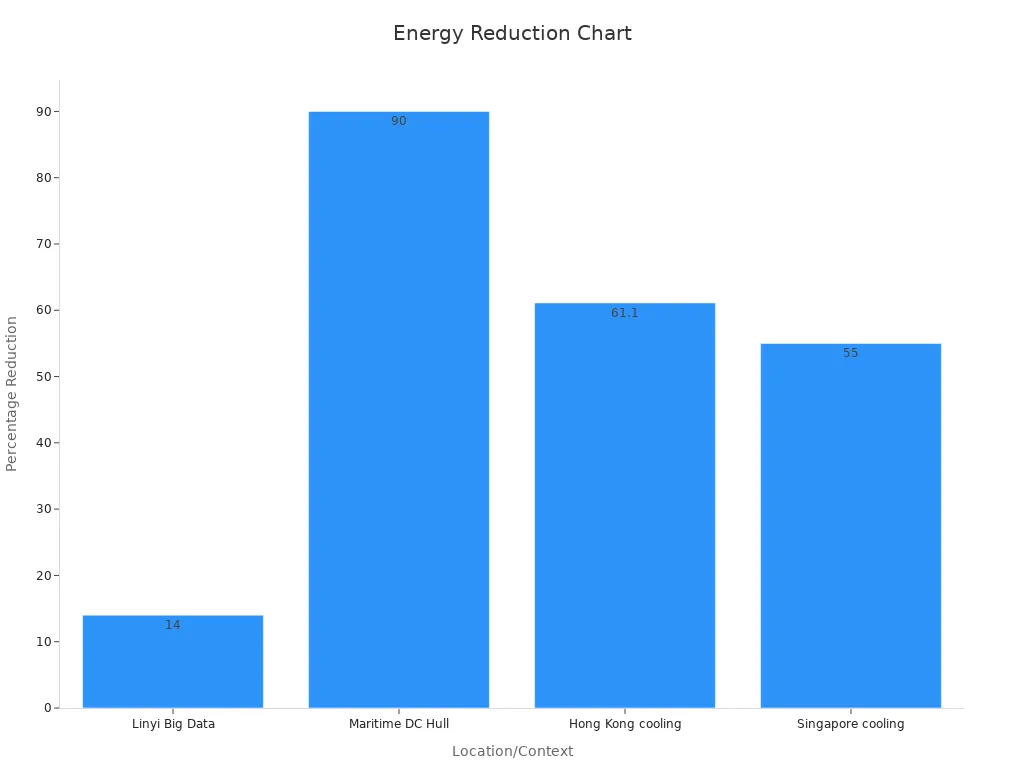How Advanced Cooling Technologies Enhance Data Center Performance

You can boost data center efficiency by adopting advanced cooling technologies. Today’s servers generate more heat than ever, with rack power densities rising from under 10 kW to over 50 kW. Traditional air cooling cannot keep up. New cooling systems, like liquid cooling and AI-driven controls, help you lower energy use and increase effectiveness.
The table below shows improvements in data center cooling effectiveness:
Metric | 2014 | 2023 | 2028 (Projected) |
|---|---|---|---|
1.6 | 1.4 | 1.15–1.35 |
These strategies drive better optimization, reliability, and sustainability for your operations.
Key Takeaways
Advanced cooling technologies like liquid cooling and AI controls lower energy use and improve data center efficiency.
Proper cooling protects equipment by preventing overheating, which extends hardware lifespan and reduces failures.
Smart cooling methods reduce operational costs by cutting power consumption and optimizing airflow.
Sustainable cooling strategies help data centers reduce water use, emissions, and meet environmental goals.
Assessing current systems and using simulation tools ensure smooth upgrades and long-term cooling performance.
Data Center Cooling Challenges
Energy Use and Inefficiency
You face major challenges with energy use in data center cooling. Cooling systems can use up to 40% of your total energy consumption. This high share shows that many systems waste energy by cooling empty spaces instead of focusing on hot equipment. When airflow is not managed well, you lose efficiency and spend more on power.
Many countries now require you to improve power usage effectiveness. For example, Germany will require a PUE of 1.5 or less by 2027. You must track and optimize this metric to stay competitive.
Aspect | Statistic / Insight |
|---|---|
Cooling system energy share | Up to 40% of total data center energy consumption |
Energy efficiency metric | Power Usage Effectiveness (PUE) measures efficiency; lower PUE is better |
Cooling inefficiency causes | High energy use by cooling systems; need for improved airflow and design |
Optimization methods | Air-side/free cooling, efficient chillers, hot/cold aisle layout |
Thermal blind spots also waste energy. New tools like robotic monitoring help you map temperatures and adjust cooling in real time, reducing waste and improving efficiency.
Equipment Reliability Risks
Poor data center cooling puts your equipment at risk. If your servers run too hot, they wear out faster and can fail early. Every 10°C rise in temperature can cut the life of your hardware in half. Problems like limescale in cooling water or blocked airflow force your systems to work harder, raising energy consumption and lowering efficiency. By keeping your cooling systems clean and well-managed, you protect your investment and avoid costly downtime.
Environmental Impact
Data center cooling affects the environment in several ways:
High energy consumption increases greenhouse gas emissions.
Water use for cooling can reach up to 25.5 million liters per year for a one-megawatt data center.
Poor efficiency leads to more power demand and higher operational costs.
Metrics like power usage effectiveness and water usage effectiveness help you measure and improve your environmental impact.
Using AI and machine learning lets you optimize cooling and reduce waste.
Some data centers use renewable energy or recycle heat and water to boost sustainability.
You can lower your environmental footprint by tracking these metrics and adopting smarter cooling strategies.
Advanced Cooling Systems

Liquid Cooling Technologies
You can use liquid cooling technologies to remove heat directly from your servers. These cooling systems work by bringing a special fluid into direct contact with hot components. This method increases the heat transfer area and reduces resistance, which helps keep temperatures low. Some systems use single-phase fluids, while others use two-phase fluids that change from liquid to gas, absorbing more heat.
Key performance metrics like Power Usage Effectiveness (PUE) and Water Usage Effectiveness (WUE) show that liquid cooling outperforms traditional air-based methods. You will see lower energy costs and better cooling system performance, especially in high-density racks. To keep your system efficient, you must monitor water quality for data center cooling. High levels of dissolved solids or hardness can cause scale and reduce efficiency. Improved water quality for data center cooling prevents fouling and corrosion, helping your equipment last longer.
AI-Driven Cooling Controls
AI-driven cooling controls help you optimize your cooling systems in real time. These smart controls use sensors and machine learning to adjust cooling based on server load and temperature.
For example, AI can increase heat dissipation by up to 6% and lower operating costs by hundreds of dollars each year.
A table below shows how AI-driven controls improve cooling:
Parameter/Metric | Value | Description/Context |
|---|---|---|
Maximum heat dissipation | 220.996 W/m | AI-optimized pipe spacing and temperature |
Minimum heat dissipation | 214.008 W/m | Wider spacing, higher temperature |
Operating cost reduction | 218 yuan | Savings with optimized insulation and pipe settings |
Feature importance ratio | 5:3:2 | Cooling pipe, insulation, spacing |
You can use AI to manage variable speed drives and intelligent controls, which further reduce energy use and improve airflow management.
Hot/Cold Aisle Containment
Hot/cold aisle containment separates hot and cold air in your data center. You arrange server racks so that cold air flows to the front and hot air exits at the back. Barriers or doors keep the two air streams apart, which stops mixing and improves cooling.
A study found that using hot/cold aisle containment with server virtualization cut power use by 28%. This change saved $1.2 million each year and kept uptime at 99.999%. You can use this method to boost efficiency and lower costs while protecting your equipment.
Passive and Evaporative Cooling
Passive and evaporative cooling systems use natural processes to remove heat.
UC San Diego engineers created a passive evaporative system that cuts energy use by up to 40%.
The system uses fiber membranes and capillary action, like plant leaves, to move water and cool surfaces.
It handles high heat loads and does not need fans or pumps.
Improved water quality helps these systems last longer and work better.
You also reduce water use and carbon emissions, making your data center cooling more sustainable.
By choosing the right cooling systems and focusing on water quality for data center cooling, you can achieve better performance, lower costs, and a smaller environmental footprint.
Data Center Cooling Efficiency Gains

Reduced Energy Consumption
You can achieve remarkable reductions in energy consumption by upgrading your data center cooling systems. Many organizations have seen major improvements in data center efficiency by using advanced technologies. For example:
ABB audits of over 10,500 motor-driven systems found average energy savings of 43%.
A CERN project improved cooling and ventilation efficiency by 17.4%, saving 31 GWh each year.
A European copper producer replaced motors and saved 25 GWh of electricity annually, with a payback period of only 3.5 years.
One data center used a free cooling system and cut energy consumption by 70%.
A commercial building installed advanced air-side cooling and reduced energy use by 40%.
You can see how these changes impact different locations and systems in the table below:
Location/Context | Energy Reduction / Performance Improvement |
|---|---|
Kao Data, London | Average PUE of 1.21 achieved with IEC (chillerless DC) |
Linyi Big Data Center, China | 14% lower PUE compared to district baseline |
Maritime DC, Hull, UK | 90% reduction in cooling energy consumption using dew point evaporative cooling |
Hong Kong | Auxiliary cooling runtime reduced by 61.1% |
Hong Kong | Annual supply-air temperature reduced by 1.7 °C |
Hong Kong | COPsys improved by 58.3% and 36.4% over two baseline systems |
Singapore | Auxiliary cooling demand reduced by 55% |
Singapore | COPsys maintained at 14.5, higher than reference systems |

You can use inverter compressors, smart thermostats, and renewable energy sources to further boost energy efficiency. These upgrades help you lower energy consumption and improve data center efficiency.
Improved Equipment Lifespan
When you improve data center cooling efficiency, you protect your equipment from overheating. Stable temperatures help your servers and hardware last longer. AI and automation adjust cooling in real time, which keeps your systems running at safe temperatures. You avoid sudden spikes in heat that can damage sensitive parts. Good airflow management and energy-efficient hardware also reduce wear and tear. As a result, you spend less on repairs and replacements, and your data center efficiency stays high.
Lower Operational Costs
You can lower your operational costs by reducing power consumption and improving effectiveness. Research shows that advanced cooling strategies cut both IT and cooling power consumption by over 15%. The table below highlights these savings:
Power Consumption Category | Power Savings Achieved |
|---|---|
IT Power Consumption | Over 15% |
Cooling Power Consumption | Over 15% |
Total Power Consumption | Over 15% |
AI and machine learning help you make real-time adjustments, which means you only use energy when you need it. Airflow management and efficient hardware also play a big role in lowering costs. New evaporative cooling technologies, like those developed at UC San Diego, show stable operation and record-breaking heat management. These improvements in energy efficiency lead to direct savings on your energy bills.
AI and machine learning algorithms reduce energy consumption.
Airflow management and efficient hardware lower power use.
These strategies help you cut operational costs and boost data center efficiency.
Sustainability Benefits
You can meet your sustainability goals by focusing on data center cooling efficiency. Modular data centers use energy-efficient cooling systems that support faster deployment and better power management. These features help you stay resilient during supply chain disruptions and align with your sustainability targets.
Power usage effectiveness (PUE) improvements of up to 30% serve as key benchmarks for energy efficiency.
Energy-efficient cooling systems support higher power densities and reduce your carbon footprint.
Liquid cooling technologies, such as Direct-to-Chip and Rear Door Heat Exchangers, provide strong thermal management and energy savings.
Retrofitting your data center with smart cooling solutions extends facility life and improves sustainability without new construction.
These benchmarks help you measure your progress and ensure your data center efficiency aligns with global sustainability standards. By using advanced cooling systems, you reduce emissions, save energy, and support a cleaner environment.
Implementing Efficient Cooling Systems
Assessing Current Infrastructure
You should start by evaluating your current data center setup. This step helps you find areas that need improvement before you add advanced cooling systems. Use these best practices to guide your assessment:
Monitor real-time power use at the rack or circuit level. This helps you balance loads and avoid overloads.
Forecast capacity to predict future needs for power, space, and cooling.
Analyze energy efficiency to spot underused resources and remove inefficient servers.
Track Power Usage Effectiveness (PUE) and Power Capacity Effectiveness (PCE) to set energy-saving goals.
Map hot and cold zones with sensors for targeted cooling.
Plan for high-density rack cooling and check if your facility is ready for liquid cooling.
Manage asset lifecycles to schedule maintenance and replacements.
Use digital twin tools to simulate layout changes before making them real.
Integration and Upgrades
When you upgrade your cooling systems, focus on solutions that match your current and future needs. Many data centers now support power densities up to 142kW per rack. You can use simulation tools to test new layouts and cooling methods before you install them. This reduces risk and saves planning time. Look for upgrades that improve energy efficiency by up to 70%. These changes can also boost AI performance and speed up on-site builds. Always follow best practices for integration to ensure smooth transitions and long-term success.
Monitoring and Maintenance
After you install new cooling systems, you need to monitor them closely. Place temperature sensors on equipment and in coolant lines. Collect data with advanced sensors and data systems. Watch for changes in temperature, vibration, and pressure. Use machine learning to predict when maintenance is needed. This approach helps you measure the effectiveness of your cooling and keeps your systems running smoothly.
Overcoming Barriers
You may face challenges like retrofitting old buildings, managing water use, or cooling high-density racks. Many organizations use immersion cooling with special fluids to handle the heat from powerful GPUs. This method can cut cooling energy use by up to 40%. Simulation tools like computational fluid dynamics help you solve thermal and mechanical problems before they happen. Modular cooling systems and liquid cooling also help you manage high power loads safely and efficiently.
You gain clear benefits when you use advanced cooling technologies in your data center. Studies show that liquid cooling and new evaporative systems lower energy use, extend equipment life, and support higher server density. These solutions also help you meet sustainability goals by reducing water and power consumption. As you plan upgrades, consider sustainable water treatment strategies to keep your systems efficient. Take steps now to improve performance and prepare for future demands.
FAQ
What is the main benefit of advanced cooling technologies in data centers?
You can lower energy use and keep your equipment safe. These technologies help you save money and improve reliability. You also support a cleaner environment by reducing your data center’s carbon footprint.
How does liquid cooling differ from traditional air cooling?
Liquid cooling removes heat directly from your servers. This method works better for high-density racks. You get more efficient cooling and use less energy compared to air cooling.
Can you use advanced cooling in older data centers?
Yes, you can upgrade older data centers with new cooling systems. You may need to plan for retrofitting. Simulation tools help you test changes before you install them.
How do you keep cooling systems running efficiently?
You should monitor temperature and airflow. Use sensors and smart controls to adjust cooling as needed. Regular maintenance and sustainable water treatment strategies help your systems last longer.
Do advanced cooling systems help with sustainability goals?
Yes, you can meet your sustainability goals with these systems. They use less energy and water. You also reduce emissions and support green initiatives in your data center.
See Also
Improving Industrial Cooling Using ARKREF CO2 Transcritical Systems
Three Key Advantages Of CO2 Refrigeration Over Traditional
Maximizing Chiller And Compressor Efficiency In ARKREF CO2 Units
Comparing Performance Between ARKREF CO2 And Traditional Refrigeration
Professional Advice To Boost Walk-In Chiller Energy Efficiency

